1961-1997. Early Life
The popular and much loved Princess Diana was born on 1st July 1961, at Park House, on the Queen's Sandringham estate in Norfolk. Christened Diana Frances, the new arrival was the third daughter of Edward John Spencer, Viscount Althorp and Frances Ruth Burke-Roche, the daughter of Maurice, Baron Fermoy and the Scottish Ruth Sylvia Gill.
Diana, Princess of Wales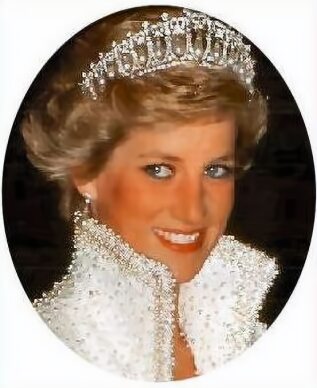
The Spencers were an established landed family who descended from the great John Churchill, Duke of Marlborough and from King Charles II. Diana had no less than four descents from Charles II, through his illegitimate offspring. These include James Scott, Duke of Monmouth, Charles' eldest son by his mistress Lucy Walter, in a bid for the crown, Monmouth led a rebellion against his uncle James II, and was later executed, Henry Fitzroy, Charles' son by Barbara Villiers, Duchess of Cleveland, Charles Beauclerk, the king's son by his most famous mistress, the actress Nell Gwyn and Charles Lennox, his son by his French mistress, Louise de Kerouaille.
During its long history, the Spencer family had produced such disparate characters as the saintly George Spencer, Father Ignatius of St. Paul, (1799-1864) a famous Jesuit and Georgiana Spencer, Duchess of Devonshire, (1757-1806) an eighteenth-century society beauty, whom the admiring George IV described as "the best bred woman in England", Georgiana, a famous gambler had several extramarital affairs and produced an illegitimate child, causing a scandal at the time.
A previous Lady Diana Spencer had narrowly missed becoming Princess of Wales, when her ambitious grandmother, Sarah Churchill, Duchess of Marlborough had planned to marry her favourite grand daughter to Frederick, Prince of Wales, the son of George II. The extremely wealthy Sarah had offered a large dowry to whet the Prince's appetite and he declared himself amenable to the match. However Sarah's plans were thwarted by the Prince's parents, who disapproved and Lady Diana was instead married off to the Duke of Bedford.
Other famous descendants of the family include the naturalist Charles Darwin, Lady Caroline Lamb, author Gavin Maxwell and U.S Presidents George Washington, Franklin Roosevelt and George W Bush.
Viscount Althorp and his wife already had two daughters, Elizabeth Sarah Lavinia and Cynthia Jane, a son, John, had been born and died shortly after and the couple were said to want a son to replace him, a male heir to inherit the Spencer title and large estates. The sensitive Diana was always to feel the profound disappointment that she had not been born a boy. The arrival of the much-desired son and heir, Charles Edward Maurice, three years later, completed the family.
Diana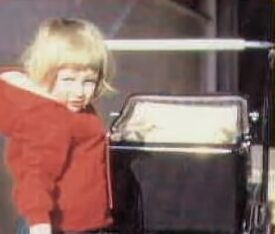
The Spencer's marriage was a stormy one and in 1967, Frances Spencer left her husband for the wallpaper businessman Peter Shand-Kydd, whom she later married. Although Frances hoped to obtain custody of her children, she was thwarted by her husband, a bitter and acrimonious court battle followed in which Earl Spencer was supported by Frances' mother, Ruth Burke-Roche, custody of the children was granted to the Earl. Frances was never to forgive this betrayal by her mother. Diana, deeply affected by her parents split, was to carry its emotional scars into adulthood. She was never to forget the scrunching sound of the gravel and the slam of a car door as her mother left the family home for good.
The Spencer children continued to see their mother regularly and often spent school holidays at Frances' new home in the northwest of Scotland. As was the custom among the aristocracy at the time, Diana was sent off to boarding school at Riddlesworth Hall and later to West Heath Girls School in Kent.
Althorp House
On the death of her grandfather, Jack Spencer, in 1975, Diana's father inherited the family title and estates and became the 8th Earl Spencer. The family left Park House and moved into Althrop, the Spencer family seat in Northamptonshire. The rambling 450 year old stately home, with its collection of old masters, was a vast and creepy place to the Spencer children but the family eventually settled into their new home.
Earl Spencer's second marriage to Raine, formerly Countess of Dartmouth and daughter of the romantic novelist Barbara Cartland, a colourful and strong-headed character, did not meet with the approval of his children, and it was never to be a peaceful household. On her arrival 'Raine stopped play' was caustically entered into the visitor book at Althorp.
When Earl Spencer suffered a near-fatal brain haemorrhage in 1978, Raine refused to let his children have access to his bedside. A situation which did little to heal the breach between the two opposing sides of Earl Spencer's family. The Earl recovered largely due to the tireless efforts of his wife, but the bitter rift between her and his children had widened.
Diana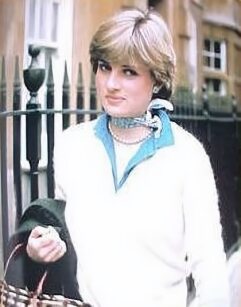
Diana was never to be academically inclined and on leaving school at sixteen without a single O level was enrolled at a Swiss finishing school, the Institut Alpin Vidamenette. Diana was then a chubby teenager who seems to have acquired the reputation of something of a glutton. She was unhappy there and terribly homesick, bombarding her parents with a constant stream of letters pleading to be allowed to return home, after two weeks they relented. On her return, her indulgent father bought her a London flat, which she shared with friends.
Diana had long-cherished childhood dreams of being a ballet dancer but had to relinquish them when she grew too tall. As she had always been fond of children, she embarked on a career first as a nanny and later as a nursery assistant at the Young England Kindergarten in Pimlico, London.
Diana's relationship with Prince Charles
The young Diana Spencer had first met her future husband, Prince Charles, in a ploughed field at Althrop. He was present at a house party as the guest of her older sister, Sarah, with whom he was conducting a romance at the time. Charles love life had long been the subject of intense media speculation. After the murder of his great uncle, Lord Mountbatten, by the IRA in 1980, which deeply affected him, the young Diana's offers of comfort touched a chord. Diana herself was very much in awe of her future spouse and throughout their courtship had to address him as Sir.
Diana seemed to fit all the specifications for a royal bride and future Queen, aristocratic, Protestant, young and without a past and Charles, under pressure from his father, the Duke of Edinburgh and the mounting media speculation about a possible engagement duly proposed and was accepted in early 1981. Diana moved into Clarence House, the London home of the Queen Mother.
She was to be perturbed and distressed when during their engagement, her fiancee sent a present of a bracelet to his old flame, Camilla Parker-Bowles. There were plentiful tears and scenes when she overheard Charles telling Camilla on the telephone, "Whatever happens, I will always love you."
Royal marriage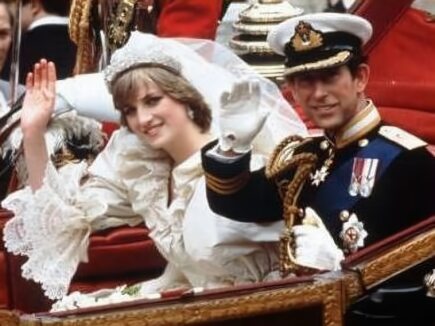
The royal marriage
The wedding of Charles and Diana couple's marriage took place at St. Paul's Cathedral on 29th July 1981. It was performed by the Archbishop of Canterbury who described it as "the stuff of fairy tales". The ceremony was watched by a worldwide television audience of an estimated one billion people.
The early part of their honeymoon was spent at Broadlands, the stately home of Lord Mountbatten, following in the footsteps of Charles' parents, who had also honeymooned there. The couple then embarked on an extended cruise of the Mediterranean on the royal yacht, Britannia. It was during this cruise that Diana's problems with bulimia nervosa were reported to have first surfaced. The princess was deeply distressed when photographs of Camilla Parker-Bowles fell from Charles' diary.
The fairy tale marriage did not get off to a very auspicious start, the fundamental differences in the two parties manifested themselves early on. Diana desperately needed support and affection as she struggled to cope with the onerous task of her new role in the fierce media spotlight that was relentlessly focused on her. This, she strongly felt, her husband failed to provide. Charles, although concerned, failed to understand his young wife's problems.
The new Princess of Wales soon became pregnant with what was hoped would be a male heir to the throne. In the early stages of her pregnancy, she was extremely unhappy. During an argument with Charles, she threw herself down the stairs at Sandringham House. Diana was found by the Queen Mother, who was greatly shocked by the experience. Fortunately, although she had some bruising around the stomach, the foetus was unharmed.
Other distressing incidents where to follow, where, desperate for attention from her husband, she threw herself into a glass cabinet and cut her wrists with the serrated edge of a lemon slicer. Throughout these troubles a public show of togetherness had to be maintained. The British public began to take 'Shy Di' to their hearts, charmed by her stunning good looks and empathetic nature, they developed a voracious appetite for photographs and magazine articles about their Princess, fueling a circulation war amongst the tabloid press.
The troubled marriage produced two sons, Prince William Arthur Phillip Louis, born on 21 June 1982 and Prince Henry Charles Albert David, known as Harry on 15 September 1984. Despite being an instant success with the public, the new Princess of Wales was haunted by her lack of self-esteem and confidence and was terrified by the huge crowds that flocked to see her at royal engagements.
The intense media interest in every aspect of her life proved to be a great strain. She continued to suffer from the eating disorder, bulimia nervosa, making her painfully thin. The illness had its roots in her troubled childhood. The strain of trying to adjust to the changes in her life and her new position, under the glare of the media spotlight, lead to depression.
Charles failed to understand his highly-strung young wife's problems and increasingly resented being upstaged at every turn by Diana, whose immense popularity overshadowed his own and showed no signs of abating. He was irked by the fact they when he made an important speech it would invariably be ignored and media attention would instead inevitably focus on what outfit his wife was wearing that day or her current hairstyle. Public interest in Diana was such that her face on the cover of a magazine or newspaper guaranteed huge sales. She was universally admired, not only for her stunning good looks and an acute sense of style but also for her gift of empathy with children, with the aged, the infirm and the dying and her ability to communicate with ordinary people.
The Princess was deeply wounded when Charles, as a consequence of the troubles in their marriage, renewed his relationship with his old flame, Mrs Camilla Parker-Bowles, a married woman with two children. As the rift in their marriage yawned to a gaping chasm, Diana was haunted by Charles' ever closer relationship with Mrs Parker-Bowles but the couple continued to put on a show of togetherness for the cameras. Diana began to deeply resent the irony of the situation and her husband's attitude toward her.
Diana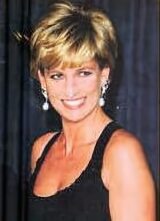
Diana, at a low ebb and as she later said, "at the end of my tether," secretly collaborated with the author Andrew Morton, in a book that exposed the royal marriage as the sham it had become and chronicled in vivid detail Diana's struggle with bulimia and the several suicide attempts the unhappy Princess had made. It also catalogued her grievances at her husband's indifference to her plight and continued relationship with his long-term mistress.
The book became a best seller overnight. Diana denied any involvement. As a direct result of the furore and scandal the book caused and Charles reaction to what he saw as total betrayal, an official separation was decided upon on 9th September, 1992.
Charles attempted to improve his battered reputation by appearing in a TV documentary with Jonathan Dimbleby, aimed at portraying him in a better and less partisan light, in which he publicly admitted his adultery with Mrs Parker-Bowles. Diana later appeared on the TV programme Panorama, where she publicly aired her grievances against Charles and famously stated, " There were three of us in this marriage, so it was a bit crowded". She also admitted her affair with army officer James Hewitt.
The Queen, concerned that her son and daughter-in-law's bickering and point-scoring was damaging the monarchy and was distressing for their children, urged the couple to divorce. They were granted a decree nisi on 28th August 1996. They agreed to share custody of their children and Diana was paid a lump sum settlement of seventeen million pounds.
Single again
The Princess indulged in a series of much-publicized relationships, her connection with Oliver Hoare, a married art dealer was splashed all over the newspapers and to her mortification, the fact that she was reported to the police and accused of making nuisance calls to his home by his wife, Diane, was made public. She became embroiled in further scandal when she was romantically connected to the rugby player, Will Carling, another married man. When it consequently caused the end of his marriage, Diana brought much criticism upon herself in the tabloids. Pakistani heart surgeon Hasnat Khan proved to be a less controversial suitor, but the relationship did not work out as he found that he could not cope with the intrusive level of press interest.
Diana and Dodi Photographed on their last journey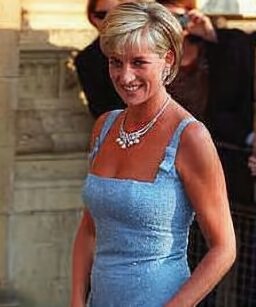
The last years of Diana's life saw an escalation of media interest, cameramen followed her everywhere in the hope of a scoop picture that would make them millions. She had naively hoped that once she left the royal family she would be able to lead a normal life but realised it was not to be. As her brother, Earl Spencer, later commented with irony, " The girl given the name of the ancient goddess of hunting, in the end, became the most hunted person of the modern age."
The Princess embarked on a campaign to ban land mines, a cause very near to her heart. Using the ever-present media attention to focus the World's attention on the plight of the many children and young people who had sustained terrible injuries and lost limbs by the deployment of these terrible weapons. Her actions were not well received by all sections of British society and some Members of Parliament labelled her a loose cannon.
Diana and Dodi Al Fayed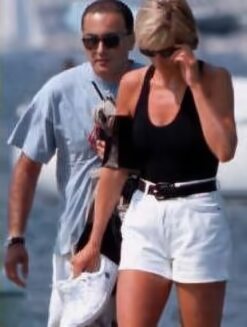
The Princess met Dodi Fayed, the millionaire playboy son of the controversial Egyptian owner of Harrod's department store, due to her stepmother Raine Spencer's friendship with Mohammed al Fayed. As rumours of a possible engagement grew, press interest in the relationship rose to fever pitch and the couple found themselves relentlessly pursued by paparazzi photographers during a Mediterranean holiday.
Such was the public interest in Diana, that photographs of her and her boyfriend on holiday together were selling at amazingly inflated prices. Cameramen jostled with each other to obtain the best shot. The couple were besieged by the notorious paparazzi in the Paris Ritz Hotel, owned by Dodi's wealthy father, during the last stage of their holiday, a planned romantic weekend in Paris.
The death of Diana
On the late evening of Saturday, 30 August 1997, in an attempt to escape these unwanted attentions, the couple left the Ritz Hotel by the rear entrance in a black Mercedes S-280, while a decoy car was driven from the front entrance of the hotel. Dodi's bodyguard, Trevor Rhys-Jones, was seated in the front next to driver Henri Paul, Diana and Dodi were in the back of the limousine, it was noted that only the bodyguard, Rhys-Jones, was wearing his seat belt, their destination was Dodi's Paris flat.
Diana and Dodi Photographed on their last journey
The vehicle was pursued by paparazzi photographers as it recklessly raced at high speed through Paris, with many of the motorbikes dropping behind. As the Mercedes entered the Pont de l' Alma tunnel under the River Seine, a notorious accident blackspot, it was on the left of two lanes, and at this point was travelling at a speed that has been estimated to be 65 m.p.h.
While attempting to pass a slow-moving vehicle in front of them in the left lane, the driver Henri Paul swerved sharply to the right, causing the rear right side of the vehicle to scrape the right wall of the tunnel. This Paul tried to correct by veering left, causing the car to career into the reinforced concrete thirteenth pillar of the underpass. Witnesses described the sound as being like an explosion. The car ricocheted back, spinning out of control. The Mercedes came to a halt, a smoking mangled heap of steel, the engine had been forced almost into the driver's seat by the force of impact. The body of Henri Paul was compressed against the steering wheel, causing it to blare out eerily into the dead of night.
Dr Frederic Mailliez, who was travelling home by the opposite carriageway of the tunnel at 12.24 a.m., pulled over, reached for his emergency bag and ran across to help tend to the victims. Dodi Fayed and Henri Paul were, unfortunately, dead, Trevor Rhys-Jones, seated in the front passenger seat, was alive but had suffered shocking facial lacerations. The Princess was seated on the floor in the rear of the vehicle, with her back to the driver's seat, her right arm, which was dislocated, bent awkwardly behind her.
To Dr Mailliez, she seemed to have the best chances of survival, Diana was found to be in a semi-conscious agitated state, flailing her arms about and muttering, partly unintelligibly. While Dr Mailliez attempted to make her more comfortable and administer oxygen, the paparazzi, who flocked around the car continued to take pictures of the dying princess from all angles through the open door of the vehicle.
The wreckage of the Mercedes
On the arrival of the emergency services, the photographers were arrested and their cameras and film confiscated. Diana received further emergency treatment in the car, witnesses reported she uttered "My God" several times, was very agitated and pulled out a drip that had been inserted. A sedative was administered to calm her and relieve her pain. Diana and Trevor Rhys-Jones were carefully and slowly extricated from the mangled wreckage and transferred to two SAMU ambulances. By this time, the Princess' condition, which until then had not been recognised to be so grave, had deteriorated markedly, her pulse was slow and the colour had drained from her face. She suffered a cardiac arrest on being removed from the wreckage, but her condition was stabilized. On the journey to the hospital, the doctor attending the Princess in the ambulance sought desperately to maintain stability of her now critical condition, the slow-moving ambulance was stopped when Diana's blood pressure fell to a dangerously low level and a further cardiac arrest was feared.
On arrival at the Pitie Salpetriere Hospital, one hour and forty-six minutes after the accident, Diana suffered a further cardiac arrest, X-rays revealed internal bleeding in the thorax, she was found to have suffered a thoracic haemorrhage from a torn pulmonary vein, she also suffered a tear in the pericardium, which is the sac in which the heart is contained. The severed vein was sewn and frantic efforts to revive her were made, including open heart massage and electric shocks, without success. By general consensus of the surgeons treating her, efforts to revive Diana were ceased and she was pronounced dead at 4 a.m. on the morning of 31st August 1997.
Prince Charles, anxiously waiting for information on his ex-wife's condition by the telephone at Balmoral in Scotland where, along with other members of the royal family, he was spending the traditional summer holiday, decided with his mother, the Queen, not to awaken the Princess' two young sons, William and Harry, until the morning. The news of Diana's tragic death was relayed to Charles shortly after and to him descended the onerous task of informing their two young sons of their mother's tragic death.
Visibly moved, Charles travelled with the Princess' two sisters, Jane and Sarah, to Paris, to collect her body and return it to England. The Princess butler, Paul Burrell, travelled to Paris with a black evening gown to see that she was suitably attired for her last journey home. The coffin was draped with the royal standard. Prime Minister Tony Blair addressed the nation on television, coining the popular phrase the People's Princess.
While her body lay in St. James' Palace, a vast sea of floral tributes began to build up outside Diana's London home at Kensington Palace, at Buckingham Palace and Althorp. In death, as in life, it seemed, she reached out to thousands. Crowds flocked to London to pay their respects, queuing for hours to sign books of condolence. Prince Charles and the couple's two young sons, William and Harry, went out into the streets to view the flowers and to meet and thank some of the massive crowds of sympathizers and well-wishers. Though William was more controlled, the young Harry's distress was evident.
Diana's Funeral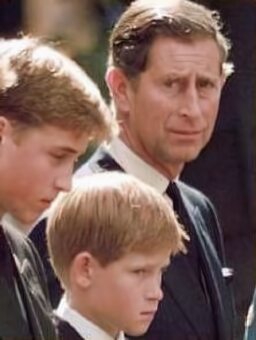
Diana's Funeral
Diana FuneralA unique state televised funeral was planned for Diana in London, watched by an estimated two billion worldwide audience. Charles, whose reputation had now reached its nadir, walked with their two young sons behind the coffin on its sad journey to Westminster Abbey, accompanied by the Duke of Edinburgh and the Princess's brother, Charles, Earl Spencer.
As tributes continued to flood in from all around the globe, the public turned up to line the route and express their grief in their millions. As the cortege passed Buckingham Palace, the royal family stood outside to express their respect and the Queen herself inclined her head to the coffin of her daughter-in-law. The royal standard above Buckingham Palace, contrary to tradition, was lowered to half-mast, following severe censure of the Queen in the newspapers. Prince William never raised his head along the long traumatic walk and the young Harry, though deeply affected, displayed much composure.
After the playing of a passage from Verdi's Requiem, a favourite of Diana, Elton John played his new rendition of Candle in the Wind, rewritten for the Princess. Her brother, Earl Spencer read his tribute to his sister in a voice cracked with emotion, it was greeted by rounds of applause from the crowds gathered outside, which reverberated into the Abbey itself, an audible censure of the Windsors.
The coffin was then taken the eighty miles to Althorp in Northamptonshire, Diana's childhood home, for a private family burial. Crowds lined the entire route, throwing flowers at the hearse, even from motorway bridges. She was buried on an island, in the middle of a lake on the estate, known as the Oval. Earl Spencer later spread the public's floral tributes to the Peoples Princess on her island grave.
The media circus that Diana's death evoked showed no sign of abating after her burial. The circulation war continued and focused on the rift between the Spencers and the Windsors, regardless of the feelings of her two grieving sons, to whom it must have been deeply offensive as they attempted to cope with their bereavement.
A visitor centre at Althorp covering the life of the Princess is now open to the public during the summer months.
Charles, Prince of Wales PreviousNext Camilla, Duchess of Cornwall
